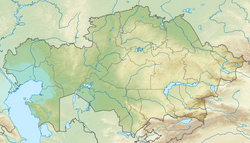1889 Chilik earthquake
| UTC time | 1889-07-11 22:14:00 |
|---|---|
| Local date | 11 July 1889 |
| Local time | 15:14 |
| Magnitude | Mw 7.9–8.0 |
| Depth | 40 km (25 mi) |
| Epicenter | 43°12′N 78°42′E / 43.2°N 78.7°E[1] |
| Areas affected | Kazakhstan, Kyrgyzstan & China |
| Max. intensity | MSK-64 X (Devastating) |
| Casualties | 92+ dead |
The 1889 Chilik earthquake occurred on July 11 on the
were killed.Tectonic setting
The geological forces at play in the
Earthquake
A post-earthquake survey of the region using reports of the earthquake's damage and effects led to the conclusion that the epicenter was located in the Chilik River Valley. No surface ruptures were identified during the survey as data was obtained via questionnaire given to eyewitnesses. The epicenter zone is elongated in the north northeast–south southwest direction approximately 100 km southwest of Almaty.[4]
The length of
In 2016, a field study of the epicenter area only identified 175 km of visible surface ruptures. Given the earthquake only had a
Another possible reason for the lack of surface ruptures is because the earthquake ruptured a neighbouring fault system in a complex rupture sequence. Due to poor accessibility for researchers, those areas hosting possible surface ruptures have not been discovered.[5]
Earlier calculation of the earthquake magnitude yielded an Ms magnitude of 8.3 in a publication by Ivan Mushketov.[6]
Frank Krüger and others suggests the magnitude of the Chilik quake has been overestimated due to the lack of abundant surface ruptures for its claimed size. A typical earthquake of this size would imply ruptures of 200 to 300 km and an average offset of 6.7 meters. He added that earthquakes in the Tien Shan region are confined to shallow depths therefore a deeper source of 40 km is debatable. Despite this, the 1978 Mw 6.9 event in the same region is the only earthquake originating at a similar depth. His team proposed a slightly lower magnitude of 8.0 Mw by analyzing surface waves of a magnetogram at two locations in England.[5] Another reassessment of the magnitude by Krüger in 2018 brought it down to 7.9.[2]
Impact
In the days before the mainshock, many survivors reported peculiar behaviors of animals, including dogs howling and cats being restless.[7]
At Verny (now
On the shores of Lake
The report by Mushketov in 1891 documented a "seismic island"—a location in meizoseismal area where shaking was weaker or not felt at all. This seismic island is located on the eastern flanks of the Tarbagatai Mountains, or in the upper Irtysh River valley. No shaking was reported in Lake Zaysan area as well.[6]
Damage
In Tüp (then Preobrajenskoe), a bridge over the Tyub River was shifted to the left bank by 1.5 meters. The quake demolished every structure made of stone and bricks. Eight people were killed in Oy-Tal, and two were seriously injured. The village was totally destroyed. In Cholpon-Ata, 39 deaths occurred, mainly due to rockfalls. Every single home; ~2,500 of them in Koram was destroyed. These clay-built homes killed 21 people when they collapsed. A nomad was buried under sand in Jyrgalang, and three 30–40-meter-long bridges fell into the Jyrgalang River. In these regions, the ground erupted tall fountains of water and sand, while in some areas, large fissures occurred.[6]
The post office in Qoyankus was destroyed. Buildings partially collapsed or suffered extensive cracks in the walls. Avalanches and landslides near
Damage to wood-constructed homes at Talgar was minimal. Only a few homes suffered a collapsed chimney in Verny. Many clay and daub homes were destroyed in Shuiding, killing an unknown number of people only described as "many" by Mushketov. Mushketov reported the effects in Yining County as same as in Shuiding.[6]
In Teploklyuchenka, Kyrgyzstan, 124 homes were demolished. One-seventh of all structures in Kyzyl-Suu were damaged.[6]
See also
References
- ^ doi:10.7289/V5TD9V7K. Retrieved 23 August 2021.
- ^ . Retrieved 17 April 2021.
- ^ .
- ^ S2CID 73665226.
- ^ S2CID 132011335.
- ^ a b c d e f g Ivan Mushketov (1891). "Materials for investigation of earthquakes in Russia". Annex to the 27th volume of tidings of the Imperial Russian Geographical Society (in Russian).
- ^ a b c Alkuat Nurmagambetov (1999). Seismic history of Almaty (in Russian). LEM. p. 68.


